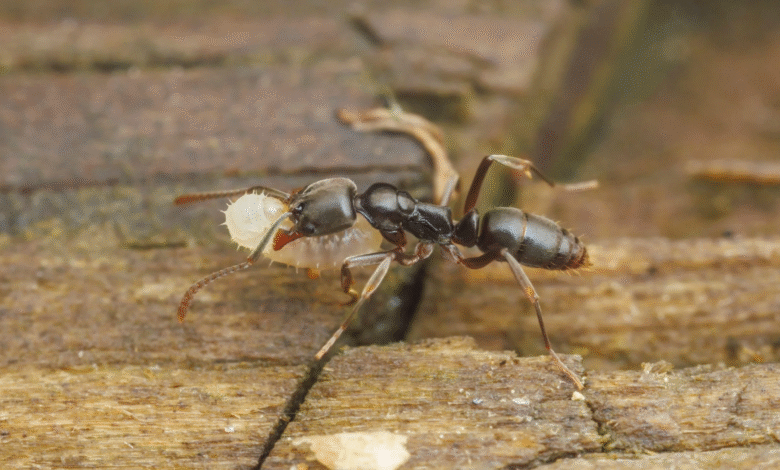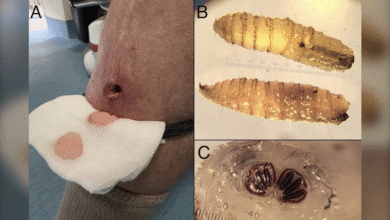Asian Needle Ant: A Medically Important Invasive Species

The Asian needle ant is rapidly becoming a significant concern across the United States as an invasive species, having spread its reach to at least 19 states. Originally hailing from regions like China and Korea, this ant was introduced to America in the 1930s; however, it remained largely unnoticed until recent reports highlighted its potential dangers. Experts stress that the sting of the Asian needle ant poses a medical threat, as it has been linked to cases of anaphylactic shock among those allergic to its venom. With its predatory nature and ability to infest undisturbed areas, the environmental impact of this invasive species is alarming, as it can disrupt native ant populations that are crucial for seed dispersal. Awareness and caution are necessary, as the ant’s hidden presence can lead to unexpected and painful encounters.
Known to some as the “cryptic ant,” the Asian needle ant quietly infiltrates ecosystems, leading to growing worries over its invasive tendencies. This species, which originates from Asia, has recently made headlines due to its ability to cause painful stings and even severe allergic reactions in susceptible individuals. The ecological balance is at risk as the Asian needle ant competes with native ant species, potentially hindering their role in forest health and plant propagation. Observers note how these ants often go unnoticed, lurking beneath leaf litter and other natural debris, creating a challenge for effective identification and management. As their population spreads, the potential for increased medical threats and environmental disruption continues to rise, underscoring the urgency of understanding this invasive ant.
The Invasive Rise of the Asian Needle Ant
The Asian needle ant, an invasive species first introduced to the U.S. in the 1930s, has become a pressing environmental concern across 19 states. Initially overlooked, experts now recognize it as a significant medical threat due to its ability to inflict painful stings. What’s alarming is that these stings have led to instances of anaphylactic shock, highlighting the urgent need for awareness and understanding of this species. With populations spreading primarily in the southeastern U.S. and reaching as far as Washington, the Asian needle ant poses a potential risk to both public health and local ecosystems.
Invasive species like the Asian needle ant disrupt local ecological balances by displacing native ant populations. This displacement can have severe environmental impacts, particularly regarding seed dispersal and the general health of various plant species. As these ants occupy undisturbed forests, the competition with native species increases, leading to a reduction in biodiversity. Researchers like Dan Suiter emphasize the need to monitor and manage these populations to prevent further ecological damage.
Understanding the Risks of Asian Needle Ant Stings
The sting of the Asian needle ant is not only painful but also poses serious health risks, such as the possibility of anaphylactic shock. According to expert reports, the ant’s sting can cause intense pain that ebbs and flows, sometimes returning even days later. This unpredictable nature of the sting makes it difficult for those affected to identify the source, particularly since the ant itself is small and cryptic, often hiding in leaf litter and shaded areas.
Individuals who are hypersensitive to other stinging insects should exercise extreme caution, as they may be more prone to severe allergic reactions from an Asian needle ant sting. In cases of stings, it’s recommended to collect the insect and present it to medical professionals for accurate treatment. This proactive approach can help emergency rooms properly diagnose and address ant sting-related allergies.
If you suspect you’ve encountered this invasive species but haven’t been stung, it’s advisable to reach out to local county extension agents for assistance with identification. They can provide valuable resources and knowledge to help mitigate the risks posed by this invasive ant species.
The Environmental Impacts of Asian Needle Ants
The environmental impacts of the Asian needle ant reach far beyond their painful stings. They disrupt local ecosystems by preying on and displacing native ant species that play vital roles in their habitats. Native ants are often crucial for tasks such as seed dispersal and soil aeration; without them, local flora may struggle to thrive. As Asian needle ants continue to spread, the ripple effects could jeopardize the ecological stability of forests and natural areas across the United States.
Furthermore, their predatory behavior means they do not follow typical ant trails, making them challenging to monitor and control. They infiltrate forested areas, nesting under logs, stones, and leaf litter, and are particularly active in the summer months. This unique behavior sets them apart from other ants, enhancing their ability to dominate local environments and create significant ecological disruption.
Identifying the Asian Needle Ant
Identifying the Asian needle ant is crucial for managing its spread and mitigating its impacts. This species is relatively small, making it easy to overlook, especially since it often resides in shaded or undisturbed areas. Characteristics such as a slender body and the ability to sting aggressively should prompt careful observation. Experts recommend familiarity with the distinguishing traits of this invasive species to help prevent unnecessary stings.
Due to its tendency to be cryptic and solitary, the Asian needle ant can be challenging to detect until populations have established themselves. Homeowners and landowners should be vigilant during the summer months when these ants are most active. If you suspect they have invaded your property, contacting pest control professionals or local agricultural extensions can facilitate appropriate identification and management strategies.
What to Do if Stung by Asian Needle Ant
If you or someone else is stung by an Asian needle ant, it is important to respond quickly and cautiously. The sting can result in significant pain and may lead to more serious health complications like anaphylactic shock, particularly in susceptible individuals. To mitigate risks, try to collect the insect to help medical professionals identify the specific ant responsible for the sting during treatment.
Seeking immediate medical attention is critical, especially for those with a history of allergic reactions to stinging insects. Providing healthcare professionals with information about the encounter can aid in effective treatment and may prevent an emergency from escalating. Staying informed and cautious about the presence of Asian needle ants in your area is vital for personal safety and community health.
The Medical Threat of Asian Needle Ants
The Asian needle ant poses a significant medical threat, largely underestimated until recent years. The species has been linked to multiple cases of anaphylactic shock, which can occur rapidly and may require immediate medical intervention. Understanding the potential severity of its sting is crucial for people living in or near affected areas. Awareness campaigns may help reduce unexpected hospital visits due to unidentified ant stings.
As awareness builds, healthcare providers are encouraged to familiarize themselves with the Asian needle ant and its potential effects. Proper identification of the ant can inform treatment plans and improve outcomes for patients suffering from its sting. It’s imperative that communities advocate for education on invasive species like the Asian needle ant to mitigate the risks they pose to public health.
Behavioral Characteristics of Asian Needle Ants
Behaviorally, Asian needle ants are distinct from many native ant species. Unlike those that follow established trails, these ants navigate their environment in a more solitary manner. This behavior complicates tracking and control efforts as they do not communicate with other ants in the same way. Their presence in quiet, undisturbed environments makes them particularly adept at establishing dominance in local ecosystems.
Moreover, their predatory nature suggests they could disrupt local food webs, potentially leading to a decline in beneficial organisms within their habitats. As research continues to unveil their behavior and interactions with other species, understanding their ecological roles becomes vital for preserving native biodiversity and ecosystem health.
Managing the Spread of Asian Needle Ants
Efforts to manage the spread of the Asian needle ant are essential for protecting both human health and local ecosystems. As this invasive species becomes more widespread, controlling its populations can prevent further disruption to native species. Experts recommend early detection and monitoring practices, as well as community education on identifying the species and understanding its risks.
Engaging local communities in monitoring and reporting sightings can provide valuable data to researchers and pest management professionals. Collaborating with agricultural extensions and environmental organizations can create a collective effort to combat this invasive threat. Prevention is key, and sharing knowledge about the Asian needle ant’s impact can equip communities with the tools needed to mitigate its spreading.
The Role of Research in Combatting Invasive Ant Species
Research plays a pivotal role in understanding the ecological and medical implications of invasive species like the Asian needle ant. Continued studies focus on the ant’s behavior, reproductive patterns, and interaction with native species, providing insights crucial for developing effective management strategies. This research is necessary to raise awareness and public understanding of the potential dangers associated with invasive ants.
By funding and supporting research initiatives, governments and agencies can better equip communities with the knowledge needed to mitigate risks. Collaboration between entomologists and public health experts can lead to more comprehensive approaches to dealing with invasive species and safeguarding both ecosystems and human health.
Future Prospects of Asian Needle Ants in America
Looking ahead, the Asian needle ant’s presence in America raises several concerns regarding environmental stability and human health. As scientists continue to study its impacts, there are calls for proactive measures to limit its spread and to monitor any changes in its behavior or population dynamics. Anticipating future expansions into new areas can help communities prepare and respond effectively to invasions.
It’s crucial that public awareness campaigns emphasize the importance of recognizing and reporting this invasive species. The collective action of informed citizens can greatly enhance efforts to manage the Asian needle ant and safeguard the ecological integrity of American forests. Ensuring that both local communities and authorities remain vigilant is key to minimizing the long-term effects of this invasive ant species.
Frequently Asked Questions
What are the dangers associated with the Asian needle ant as an invasive species?
The Asian needle ant is considered a medically important invasive species due to its painful sting that can lead to serious medical threats, including anaphylactic shock. Its introduction to the U.S. has raised concerns as it has spread to at least 19 states, potentially displacing important native ant species and impacting local ecosystems.
How does the sting of the Asian needle ant compare to other ant species?
The sting of the Asian needle ant is particularly troubling as it can cause severe pain that may recur days after the initial sting, unlike many other ant species. This characteristic has resulted in emergency room visits for victims experiencing anaphylactic shock and delayed pain response.
Why is the Asian needle ant considered a medical threat in the U.S.?
The Asian needle ant poses a medical threat due to its potential for causing anaphylactic shock in sensitive individuals. Reports have indicated that at least three people required hospitalization for allergic reactions last year, highlighting the urgency for awareness and caution regarding this invasive species.
What environmental impacts does the Asian needle ant have on native ecosystems?
The Asian needle ant can have significant environmental impacts as it displaces native ant species that play crucial roles as seed dispersers. This disruption can hinder the growth of native plants and alter the ecological balance in undisturbed forest areas where the ant nests and thrives.
What should you do if you are stung by an Asian needle ant?
If stung by an Asian needle ant, it’s recommended to seek immediate medical attention, especially if you experience severe reactions. Bring the ant with you to the medical professional to confirm the species responsible for the sting, which can assist in appropriate treatment.
How can you identify an Asian needle ant in your area?
The Asian needle ant can be identified by its small size and solitary behavior, as it often travels alone rather than in trails like other ant species. They typically nest in quiet, undisturbed areas under logs, stones, or leaf litter. If you suspect an infestation, contact your local county extension agent for assistance in identifying the ant.
What precautions should be taken regarding the Asian needle ant if you have allergies?
Individuals with known allergies to stinging insects should exercise caution in areas known to host the Asian needle ant. Awareness of its presence and prompt action in the case of a sting can reduce the risk of severe allergic reactions, including anaphylaxis.
How did the Asian needle ant first spread to the United States?
The Asian needle ant was first introduced to the U.S. in the 1930s, likely through human activities. It initially went unnoticed for several decades, but it has since spread to 19 states, raising alarms about its status as an invasive species impacting both human health and native ecosystems.
| Key Points |
|---|
| The Asian needle ant is an invasive species that poses a medically significant threat to humans due to its painful sting and potential to cause anaphylactic shock. |
| Originally native to China and Korea, the Asian needle ant was introduced to the U.S. in the 1930s but has only recently garnered attention as it spreads across 19 states. |
| The sting of the Asian needle ant is unique; pain may vanish and then return unexpectedly days later, leading to confusion regarding the source. |
| The species is mostly found in undisturbed forests, nesting under logs, stones, and leaf litter, making them difficult to detect and leading to potential harm to native ant populations and ecosystems. |
| Invasive Asian needle ants are mostly solitary and predatory, unlike many other ant species, making them cryptic and hard to observe. |
| There is a concern that the Asian needle ant may impact the growth of native plants and disturb ant species critical for seed dispersal. |
| If stung, individuals should seek medical attention and bring the insect for proper identification, especially if they are hypersensitive to stings. |
Summary
The Asian needle ant presents a growing health risk in the United States as it expands its range across various states. With its painful sting and potential to induce anaphylactic shock, awareness of this invasive species is crucial for preventing severe reactions, especially among those with sensitivity to insect bites. Its ability to disrupt local ecosystems further emphasizes the need for vigilance and proactive measures to manage this invasive ant’s impact.




